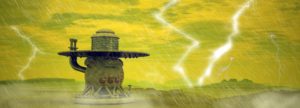Nuclear Waste in the Summer of Venus
Tony Washburn was on his great interplanetary mission. He did not want to confess, but it was not his big dream. He saw his colleagues being in charge of large projects, some for true pioneer missions and that they would give them fame, but he only had to carry trash to Venus.
A project from the Space Academy of Nuclear Waste. So he was allocated to his work, inside the EPP-Earth Planet Purifier. After years of training and simulations, it was his turn to lead the mission of bringing nuclear waste to the planet Venus.
After decades of groundbreaking research into rocket, fuel, nuclear waste handling and robotics, the spacecraft would benefit from the journey of a few years toward the Sun.
Before, however, there was a quick stop to supply his ship. Captain Washburn was taking a small group of trainees to the space shuttle and explaining what was happening at the refueling stop.
“We will have examples of fuels in every state on the ship. Here we had in the stage of leaving the Earth, the propulsion via hybrid fuels solid and liquid. Abandoning stage 1, we will be consuming from the methane containers.”
The Captain perceived a certain lack of enthusiasm from the group and kept a serious and rather somber face. The trainees sought to maintain their focus with full attention to the presentation.
“Methane is being produced by intelligent containers in the Earth’s atmosphere. They spent years absorbing Methane until they reached full load. Then they came to our orbit, where by means of navigation Robots, they filled up that large reservoir of Methane that we just coupled in our stage 2. It will be our fuel up to Venus. With less thrust, we will go towards the Planet with full conditions of navigation. With regard to nuclear waste, they also came in special containers and have been in orbit for some years. Other Robots will group them together and thus they will be our main burden. “
“The fragmentation of cargo and fuel over the years has been key to increasing the safety of handling nuclear waste, since before all nations blocked projects like ours. Today we know that the whole operation is much safer and unlikely any disaster as we had in the early days of Nuclear Technology. “
“Space Robotics was another item that completely transformed our business. EPP would not exist without the Robots who organize all work for our journey in the direction of the Sun. Venus did not forbid Earthlings to dump their nuclear waste on the planet. And another class of Robots on the surface of Venus organize everything. They sort, move and store the garbage. They are Robots with resistance to the very high temperatures of the Planet, but they do, however, basic and rather gross operations. We do not have as much robotic intelligence on the surface of Venus. “

So many months passed …
After the new takeoff of Earth’s orbit, and now the EPP was approaching Venus. In the routine of the ship, everything was well and everyone waited for the arrival on the planet for the operation of launching the cargo towards the hot surface of the planet. When this period finally came to an end, they all gathered for a new meeting in the ship’s main observation room.
The panel satellite probes in the atmosphere of Venus transmitted images to the ship. From the approach a motion picture with high resolution and color, can be sent from the probes to the ship. The captain called attention to the region of the nuclear waste depot and little by little something strange can be perceived.
All observed a practically stabilized violet mist over some of the chemical residues. There was a computer on board with a database and intelligence capability greater than the robots or probes in the orbit of Venus. Everyone feared that there might be some nuclear explosion, luminescence or even a radioactive material leaking into the surface of Mars. It was unlikely since the material that had been shipped was “resistant” to high temperatures, remaining stable in those conditions, in the way it had been segmented and stored. The temperature on the surface of Venus was 480 ° C (or 900° F) and the recycled radioactive materials had much higher melting point, generally above 600° C.
However, there were several components in the waste. Captain Washburn waited for the report of the main computer and reported that there was already a good guess for the violet cloud.
“Dear crew, the EPP computer says we have more than a 99% chance that the violet mist is gaseous iodine. Iodine has a melting point of 457 ° C, and possibly was present in some recycled compartments, mixed in the other materials. However, no explosion was detected. The surface containers have a characteristic of adaptation to high temperatures, and possibly there was a controlled leakage of iodine in the gaseous state under these conditions, but within a plausible normality.
“What you see now is a passing cloud of Iodine. At some point, the weather will “open” until the containers. But we need to move on to the next phase. Let’s play with a long-distance throw on Venus? “
The trainees, almost without taking their eyes off the unusual scene, made notes and ecstatic, waiting for the next event.
Main Imagem from “GoKingSword” at Pixabay.com